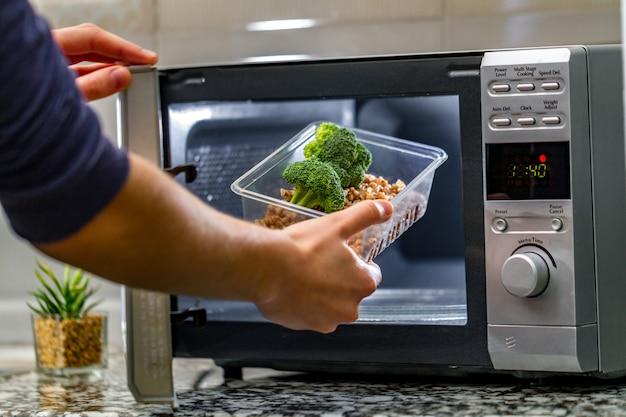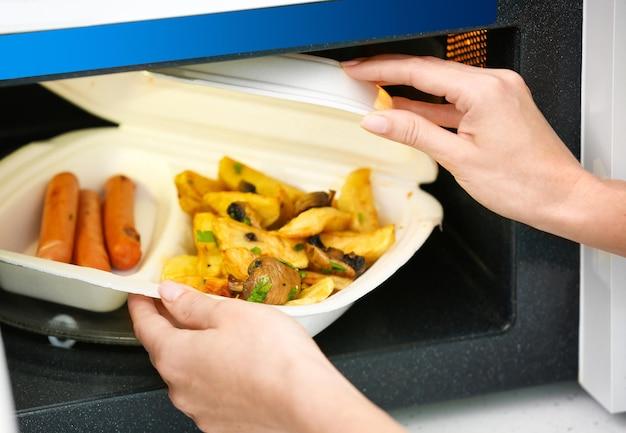Microwaves have become an essential kitchen appliance for their convenience and time-saving abilities. We often rely on plastic containers to reheat or cook our favorite meals in the microwave. However, questions about the safety of heating plastic in this way have begun to arise. Is it harmful to microwave plastic? How long is it safe to keep a plastic container in the microwave? In this blog post, we will explore the answers to these questions and debunk some common myths.
If you’ve ever wondered about the potential dangers of microwaving plastic, you’re not alone. Concerns about chemicals like BPA (Bisphenol A) have led to the development of BPA-free plastics, but are they entirely safe? We will investigate whether BPA-free plastic is still harmful, and which types of plastics are considered safe for microwave use. Additionally, we will delve into the topic of temperature, discovering at what point plastics may start to leach harmful substances when exposed to heat.
So, if you’re eager to learn more about the safety of microwaving plastic containers and want to ensure you’re protecting yourself and your loved ones, keep reading. We will provide valuable insights and guidelines for using plastic in the microwave to help you make informed decisions in your kitchen.
How Long Can You Put a Plastic Container in the Microwave
When it comes to microwaving food, we all know that plastic containers are a convenient option. They’re lightweight, easy to clean, and come in all shapes and sizes. But have you ever wondered just how long you can safely keep that plastic container in the microwave? Well, you’re in luck because we’re about to uncover the secrets of plastic microwaving mastery!
Understanding the Microwave-Safe Symbol
Before we dive into the specifics, let’s talk about the mysterious symbol you often find on plastic containers—the microwave-safe symbol. This symbol, which looks like a microwave oven, indicates whether a particular plastic container is suitable for use in the microwave. It’s like a secret code that tells you whether your container can handle the heat!
Decoding the Microwaving Times
Now that we’re familiar with the microwave-safe symbol, let’s get down to business—the actual microwaving times for plastic containers. While there’s no one-size-fits-all answer, it’s generally recommended to microwave plastic containers for short bursts of time.
For most plastic containers, a microwaving time of 1-2 minutes is usually safe. This allows the container to heat up the food without reaching excessively high temperatures. However, if you’re dealing with a more delicate plastic or a container that doesn’t have the microwave-safe symbol, it’s best to err on the side of caution and keep microwaving time to a minimum.
Understanding the Melting Point
One of the key reasons why you need to be mindful of microwaving times is the dreaded “m” word—melting. Plastic containers can melt if they’re exposed to high temperatures for extended periods. And nobody wants a melted mess in their microwave!
The melting point of plastic can vary depending on the type of plastic, but it typically ranges from 170 to 220 degrees Celsius (338 to 428 degrees Fahrenheit). While microwaves don’t usually reach these temperatures, prolonged exposure can still cause plastic to warp, deform, or even release harmful chemicals. So, it’s wise to stick to shorter microwaving times.
Tips for Safer Microwaving
To keep your plastic containers and your microwave happy and healthy, consider these tips:
Don’t Dishonor Your Containers:
Choose microwave-safe containers made from materials like polypropylene (PP), high-density polyethylene (HDPE), or low-density polyethylene (LDPE). Avoid containers made from polystyrene (PS) or polyvinyl chloride (PVC) as they aren’t microwave-friendly.
Play it Cautious with High-Fat Foods:
Foods that are high in fat can heat up more quickly, causing the plastic container to become hotter than the food itself. So, be cautious when microwaving those cheesy lasagnas and buttery baked potatoes!
Give Breathing Room for Steam:
Plastic containers with airtight lids can trap steam, leading to increased pressure and potential deformation. To avoid this, leave a small gap or vent the lid slightly to allow steam to escape. Your container will thank you!
Inspection is Key:
Regularly inspect your plastic containers for any signs of wear and tear like cracks, discoloration, or warping. If you notice any damage, it’s best to retire the container to prevent potential mishaps while microwaving.
With these tips in mind, you’ll be well-equipped to make informed decisions about microwaving plastic containers. So go forth, heat your leftovers, and conquer the microwave, fearless foodie!
FAQ: How Long Can You Put A Plastic Container In The Microwave
Is it safe to boil water in BPA free plastic
Yes, it is generally safe to boil water in BPA-free plastic containers. BPA (Bisphenol A) is a chemical commonly found in certain types of plastic that can seep into food or drinks and may have negative health effects. However, BPA-free plastics are made without this harmful chemical, making them a safer option for boiling water or storing hot liquids.
What happens if you microwave plastic
Microwaving plastic can lead to a variety of undesirable outcomes. When plastics are exposed to high heat in the microwave, they can melt, warp, or release harmful chemicals into your food. This can not only affect the taste and texture of your meal but also pose potential health risks. It is best to use microwave-safe containers specifically designed for heating food.
Is BPA-free plastic still bad for you
BPA-free plastic is certainly a step in the right direction when it comes to reducing potential health risks associated with plastic use. However, there is ongoing research about alternative chemicals used in BPA-free plastics, and their long-term effects are not yet fully understood. While BPA-free plastic is generally considered safer, it’s always prudent to minimize plastic usage and choose alternative materials like glass or stainless steel whenever possible.
Which plastic is safe for hot water
Plastics labeled as “food-grade” or “heat-resistant” are generally safe for hot water. High-quality plastics such as polypropylene (PP) and high-density polyethylene (HDPE) are often used for products that come into contact with hot liquids. Look for these labels and symbols indicating microwave or heat resistance to ensure the plastic is suitable for hot water.
What plastic is safe to microwave
When it comes to microwaving food, it is crucial to use microwave-safe plastics. Look for containers labeled as microwave-safe or specifically designed for microwave use. Common microwave-safe plastics include polypropylene (PP), high-density polyethylene (HDPE), and polyethylene terephthalate (PET). Always check the manufacturer’s instructions and any symbols indicating microwave safety before using plastic in the microwave.
How long can you microwave a plastic container
The length of time you can safely microwave a plastic container depends on various factors, such as the type and thickness of the plastic, the power of your microwave, and the specific food being heated. As a general rule, it’s recommended to microwave in short intervals of 1-2 minutes and check the container for any signs of melting or warping. If the plastic shows any damage or stress, it’s best to transfer the food to a microwave-safe alternative.
Can I microwave Tupperware
Yes, many Tupperware products are microwave-safe. Tupperware, a well-known brand, offers a range of microwave-safe containers that are specifically designed for heating and reheating food in the microwave. It’s always essential to check the specific instructions or symbols on the Tupperware product to ensure its microwave safety.
Is microwave cancerous
No, using a microwave oven does not cause cancer. Microwave ovens use non-ionizing radiation to heat food, which is different from the ionizing radiation used in X-rays and other medical procedures. As long as you use microwave-safe containers and follow the manufacturer’s instructions, microwaving food is a safe and convenient method of heating.
Is #5 plastic microwave-safe
Plastic items labeled with the recycling number #5, also known as polypropylene (PP), are generally considered microwave-safe. However, not all #5 plastics are suitable for microwave use, so it’s crucial to check the manufacturer’s instructions or look for specific microwave-safe symbols on the plastic item before microwaving.
How do I know if plastic is microwave-safe
To determine if plastic is microwave-safe, you can look for specific symbols on the plastic item. Common symbols include “microwave-safe” or the image of a microwave itself. Additionally, some plastic products may display instructions stating that they are safe for microwave use. Always follow these guidelines to ensure safe and effective use of plastic in the microwave.
At what temperature does plastic leach
Plastics can start to leach chemicals when exposed to high temperatures. The specific temperature at which leaching occurs can vary depending on the type of plastic. As a general guideline, it is advisable to avoid exposing plastics to temperatures above 100 degrees Celsius (212 degrees Fahrenheit). When using plastic for food storage or microwave heating, it’s best to stay within lower temperature ranges to minimize the risk of chemical leaching.
Is it safe to put hot food in a plastic container
As long as you are using microwave-safe and heat-resistant plastics, it is generally safe to put hot food in a plastic container. However, it is always advisable to exercise caution and choose alternatives like glass or stainless steel whenever possible, especially for foods with high oil or fat content. Heat-resistant plastics labeled as microwave-safe are designed to withstand the heat generated by hot foods without leaching harmful chemicals.
What happens if you cook meat with plastic
Cooking meat with plastic is not recommended, as it can lead to the melting or warping of the plastic. Furthermore, heating meat in plastic containers or wraps can potentially cause harmful chemicals to leach into the food, compromising its safety and quality. To cook meat safely, it is advisable to use appropriate cookware such as oven-safe glass or stainless steel pans.
Is Tupperware plastic safe for food
Tupperware, a reputable brand, offers a range of plastic containers that are specifically designed for food storage and are generally safe for use. Tupperware uses food-grade plastics like polypropylene (PP) and polyethylene (PE), which are known to be safe for food contact. However, remember to check the specific instructions or symbols on the Tupperware product to ensure its suitability for different food storage and heating purposes.
What is the microwave-safe symbol on Tupperware
Tupperware products usually bear a symbol depicting a microwave-safe icon, often represented by wavy lines or a microwave oven. This symbol indicates that the Tupperware item is safe to use in the microwave. Always look for this symbol or specific instructions from Tupperware to ensure proper usage.
What happens if you eat plastic wrap
Accidentally ingesting a small amount of plastic wrap is generally harmless and will likely pass through the digestive system without any significant effects. However, it’s always best to avoid consuming plastic wrap. If you believe you have ingested a larger piece or experience any concerns, it is advisable to contact a healthcare professional for proper advice.
Is all plastic BPA-free
Not all plastic is BPA-free. Bisphenol A (BPA) is a common chemical used in some plastics, particularly in those with recycling numbers #3 and #7. However, due to increasing health concerns, many manufacturers now produce and label plastic products as BPA-free. It is essential to check the product labeling or contact the manufacturer to determine whether a specific plastic item is BPA-free.
Is it safe to microwave BPA-free plastic
Microwaving BPA-free plastic is generally considered safe. BPA-free plastics are manufactured without the use of bisphenol A, a chemical that has been linked to potential health risks. However, it’s always a good idea to follow the manufacturer’s instructions and guidelines for microwave use to ensure the plastic’s safety.
Can I put a plastic container in the microwave
You can put a plastic container in the microwave, but it must be specifically labeled as microwave-safe. Using microwave-safe containers ensures they can withstand the heat generated by the microwave without warping, melting, or releasing harmful chemicals into the food. Always check the manufacturer’s instructions or symbols on the plastic container to determine its microwave safety.

